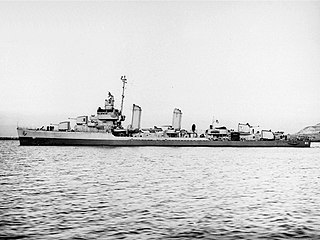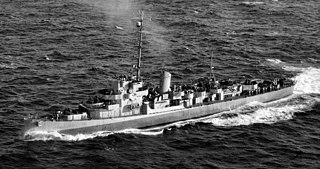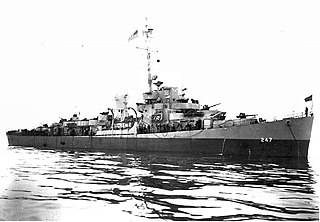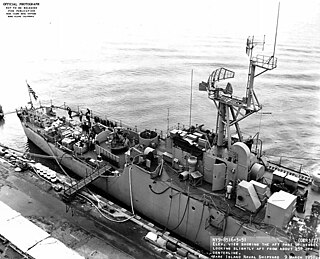
USS Jacob Jones (DD-130), named for Commodore Jacob Jones USN (1768–1850), was a Wickes-class destroyer. Jacob Jones was laid down by the New York Shipbuilding Corporation at Camden, New Jersey on 21 February 1918, launched on 20 November 1918 by Mrs. Cazenove Doughton, great-granddaughter of Commodore Jones and commissioned on 20 October 1919, Lieutenant Commander Paul H. Bastedo in command. She was sunk by a German submarine in 1942 during World War II.

USS Goff (DD-247) was a Clemson-class destroyer in the United States Navy during World War II. She was named for Secretary of the Navy Nathan Goff, Jr.

USS Wilkes (DD-441) was a Gleaves-class destroyer commissioned in the United States Navy from 1941 to 1946. After spending several decades in the reserve fleet, the destroyer was scrapped in 1972.

USS James C. Owens (DD-776), an Allen M. Sumner-class destroyer, is the only ship of the United States Navy FRAM II class to be named for Lieutenant James C. Owens Jr., a member of Torpedo Squadron 8 on board USS Hornet. His entire squadron was lost in an attack against Japanese aircraft carriers 4 June during the Battle of Midway. Lt. Owens received the Navy Cross and the Presidential Unit Citation (US) posthumously.

The third USS Trippe (DD-403) was a Benham-class destroyer in the United States Navy. She was named for John Trippe.

USS Jeffers (DD-621/DMS-27), a Gleaves-class destroyer, was the only ship of the United States Navy to be named for Commodore William N. Jeffers.

USS Rhind (DD-404) was a Benham-class destroyer in the United States Navy. She was named for Alexander Colden Rhind.

USS Hilary P. Jones (DD-427) was a Benson-class destroyer in the United States Navy during World War II. She was named for Admiral Hilary P. Jones.

USS Loy (DE-160/APD-56), a Buckley-class destroyer escort in service with the United States Navy from 1943 to 1947. She was converted to high-speed transport (APD) in late 1945. Following her decommissioning, she spent another 19 years in reserve before being sold for scrap in 1966.

USS Alexander J. Luke (DE/DER-577), a Buckley-class destroyer escort of the United States Navy, was named in honor of Sergeant Alexander J. Luke (1916–1942), who was killed in action during the attack on Tulagi on 6 August 1942. He was posthumously awarded the Silver Star.

USS Robert I. Paine (DE/DER-578), a Buckley-class destroyer escort of the United States Navy, was named in honor of Marine Corps Private Robert I. Paine (1923-1942), who was killed in action during the attack on Tulagi on 7 August 1942. He was posthumously awarded the Silver Star.

USS Kalk (DD-611) was a Benson-class destroyer in the United States Navy during World War II. She was the second ship named for Lieutenant Stanton Frederick Kalk.

USS Kendrick (DD-612) was a Benson-class destroyer in the United States Navy during World War II.

USS Stewart (DE–238) is an Edsall-class destroyer escort, the third United States Navy ship so named. This ship was named for Rear Admiral Charles Stewart, who commanded USS Constitution during the War of 1812. Stewart is one of only two preserved destroyer escorts in the U.S. and is the only Edsall-class vessel to be preserved. She is on display in Galveston TX as a museum ship and is open to the public.

USS Willis (DE–395) was an Edsall-class destroyer escort of the United States Navy.

USS Burrows (DE-105) was a Cannon-class destroyer escort built for the U.S. Navy during World War II. She served in both the Atlantic Ocean and the Pacific Ocean, and provided escort service against submarine and air attack for Navy vessels and convoys.

USS Tomich (DE-242) was an Edsall-class destroyer escort in service with the United States Navy from 1943 to 1946. She was scrapped in 1974.

USS Stanton (DE-247) was an Edsall-class destroyer escort built for the U.S. Navy during World War II. She served in the Atlantic Ocean the Pacific Ocean and provided destroyer escort protection against submarine and air attack for Navy vessels and convoys.

USS Joyce (DE-317) was originally commissioned as a US Coast Guard Edsall-class destroyer escort built for the U.S. Navy during World War II. She served in the Atlantic Ocean and the Pacific Ocean and provided destroyer escort protection against submarine and air attack for Navy vessels and convoys. During its World War II service, on two different engagements with enemy submarines, the Joyce rescued survivors of the tanker SS Pan- Pennsylvania and its sister ship USS Leopold. Joyce received one battle star for its service during World War II.

USS Wilhoite (DE-397) was an Edsall-class destroyer escort built for the United States Navy during World War II. She served in the Atlantic Ocean and the Pacific Ocean and provided destroyer escort protection against submarine and air attack for Navy vessels and convoys.




















